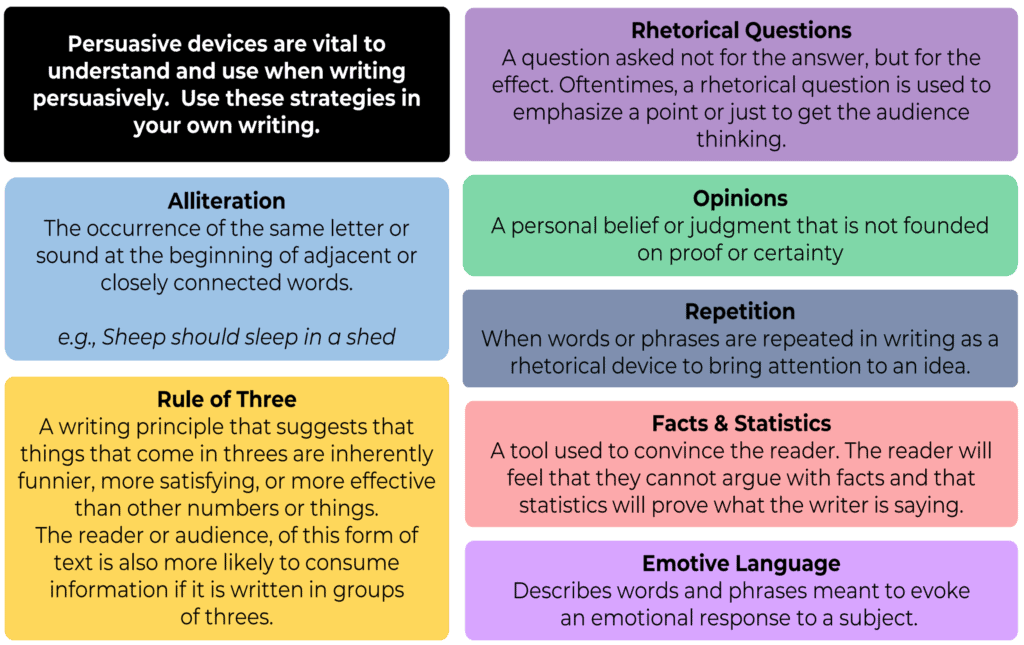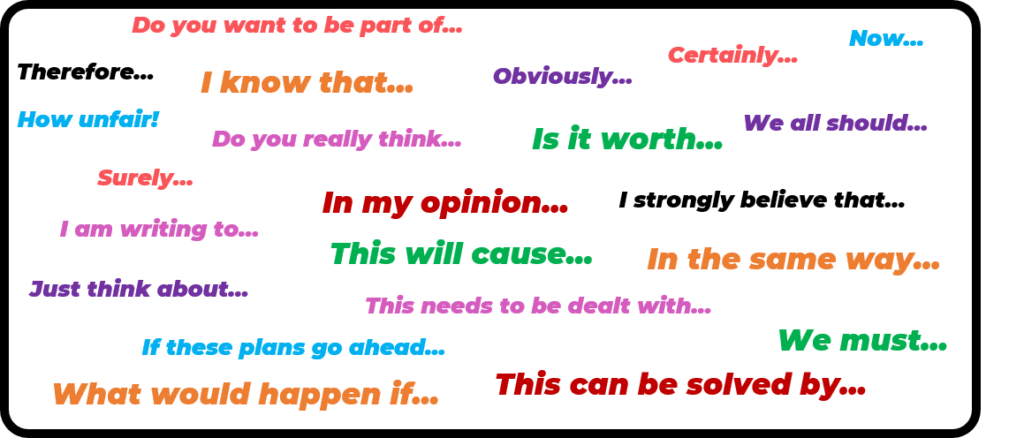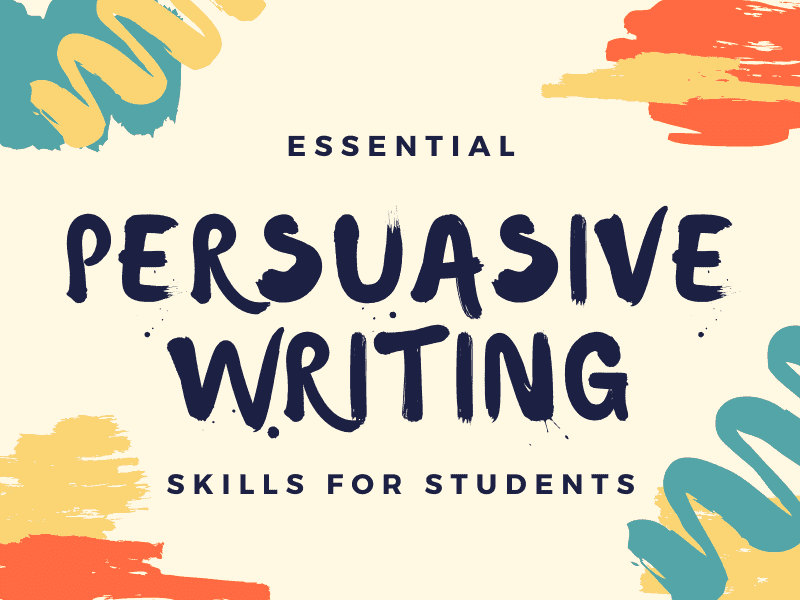

As with persuasive texts in general, advertisements can take many forms – from billboards and radio jingles to movie trailers and pop-ups on your computer.
In this guide, we’ll focus on creating a standard magazine-format advertisement, commonly known as a print ad.
Print ads are text-heavy enough to provide substantial content for students to delve into and practice their skills.
While advertisers increasingly shift toward more trackable and often cheaper digital advertising, the same strategies and techniques remain applicable to both formats.
Likewise, strategies such as emotive language and other persuasive devices are essential when writing ads. Much of the writing advice that follows applies to the other persuasive texts, which can also be found on our site. Be sure to check it out, also.
Let’s explore the structure and persuasive elements that make an advertisement successful. These elements combine to make us think and act favourably about a service or product. So let’s get into it and learn how to write an advertisement.
A COMPLETE UNIT ON ADVERTISING FOR TEACHERS & STUDENTS
Teach your students essential MEDIA LITERACY SKILLS with this COMPLETE UNIT on ADVERTISING. It’s packed with ENGAGING, INFORMATIVE & FUN activities to teach students the persuasive techniques to READ ADVERTS and the skills to WRITE ADVERTS.
This COMPLETE UNIT OF WORK will take your students from zero to hero over FIVE STRATEGIC LESSONS covered.
PERSUASIVE TECHNIQUES TUTORIAL VIDEO (2:20)
STRUCTURE AND FEATURES OF ADVERTISEMENTS (PERSUASIVE ELEMENTS)
For students to create their own advertisements and successfully employ various persuasive techniques, they’ll first need to develop a clear understanding of an advertisement’s underlying structure.
We’ll explore the primary structural elements and features of advertisements, though the order in which these appear can vary from advert to advert. Here, we’ll take a look at the following persuasive text elements.
- Brand Name
- Audience
- The Image
- Logo
- Call to Action
- The Offer
- Headline
- Slogan
- Body Copy

THE BRAND NAME AS A PERSUASIVE ELEMENT

The brand name of the product or service frequently comes at the top of the advertisement – though not always. One of the first tasks for students when writing their own advertisement is to decide on a name for their product or service.
Please encourage students to select a name that reflects the product, service, or values they wish to present to their audience.
Brand names have evolved from being wordy and aspirational to very short and snappy since the inception of the internet, so they can be found easily on a search engine.
BRAND NAME CONSIDERATIONS
- What are the names of similar already existing products or services?
- Does the name look and sound good?
- Is the name short, punchy, and memorable?
- Does it evoke a feeling or an idea?
- Is it distinctive and original?
THE AUDIENCE AS A PERSUASIVE ELEMENT

An advertisement’s target audience may not always be immediately apparent and often needs to be inferred through language and imagery choices made by the writer.
However, who the target audience does need to be decided before writing as it will inform subsequent choices on the use of language (e.g. pronouns, tone, etc.) and imagery.
There are several ways to help students determine their target audience.
A good starting place is to consider creating a target persona—a fictional character who represents the type of person their product or service is aimed at.
- Age
- Gender
- Location
- Hobbies
- Income
- Education level
- Occupation
- Marital status
- Likes/Dislikes
- Who they trust
- What they read/watch
An effective print advertisement presents a product or service in an appealing manner. It quickly conveys essential information about that product or service. It will include a clear and specific offer and also provide the information required for the reader to act on that offer.
Once we have the brand name sorted and the audience defined, it’s time to look at the critical structural elements to consider when writing an ad. It’s important to note that not every element will be used in every ad, but the following model serves well for writing most print advertisements.
THE HEADLINE AS A PERSUASIVE ELEMENT

The ad headline should provide a short, snappy preview of what the reader will find in the copy. A good headline grabs the potential customer’s attention and entices them to read the rest of the ad.
There are several tried-and-tested methods for writing a great headline. Here are three of the most effective:
The Problem/Solution Headline – This headline details a problem a potential customer may be facing and offers the solution in the form of the product or service. For example: Tired? Sluggish? Overweight? Excero Bike Gets You Where You Need to Go, Fast!
The Testimonial Headline – This headline uses a quote from a customer’s positive review to help sell the product or service. The testimonial allows the potential customer to see some ‘proof’ upfront before buying. “With the Excero Bike, I lost 15lbs in 15 days. I’m now thinner, fitter, and much, much happier!”
The Question Headline – This headline asks a question that the target customer will be seeking an answer to, for example, “Are you paying too much for your x?” Are You Paying Too Much for Your Gym Membership?
FREE Advertising Task Matrix
Looking for an engaging way to teach advertising concepts? Download our FREE Bloom’s Taxonomy Advertising Matrix, perfect for empowering students to explore the world of advertising at their own pace. Including activities for analyzing advertisements, evaluating persuasive techniques, and creating original campaigns.

THE LOGO AS A PERSUASIVE ELEMENT

Logos are visual representations of a brand, used to promote a range of products and services under a single umbrella while allowing for quick recognition by the reader.
Though logos are primarily a design element rather than a writing one, they play a vital role in reinforcing brand identity and trust. A well-designed logo communicates the essence of a brand in a single glance, conveying professionalism, reliability, and values.
Logos are especially important in building consistency across various marketing materials, from advertisements to social media posts. They act as a visual anchor, helping consumers associate positive experiences with the brand.
Simple, memorable designs are often the most effective, ensuring the logo remains recognizable across different platforms and formats.
THE SLOGAN AS A PERSUASIVE ELEMENT

A slogan is a phrase or a short sentence used to represent or sell a particular brand.
Slogans are typically designed to be short and snappy, making them more memorable for readers. They often incorporate figurative language techniques like alliteration, rhyme, or puns to leave a lasting impression.
A well-crafted slogan distills the essence of a brand or product into a few impactful words, creating a connection with the audience and reinforcing brand identity.
Whether clever, emotional, or aspirational, a great slogan helps a brand stand out in a competitive market and stick in the minds of consumers.
THE OFFER AS A PERSUASIVE ELEMENT

A good print ad makes readers an offer. This is usually in the form of a benefit the potential customer will gain or a motivating reason for finding out more about the product or service.
The Offer acts as a ‘hook’ that maintains the reader’s focus and draws them into the body of the ad. It can be a time-limited discount or a 2-for-1 offer, etc. This Week Only – 25% Off!
Offers can also form part of the Call to Action at the end of the ad – more details on this soon.
THE BODY COPY AS A PERSUASIVE ELEMENT

Good body text (or body copy) in an ad is well-organized and quickly gets to the point. Readers want to obtain the necessary information with minimum effort.
For the writer, this requires skill, patience, and much editing. There are several different types of body copy that students need to consider when writing their ads. Let’s take a look at five of these:
Factual – Factual copy gives the reader just enough factual information about the product or service to persuade them that it’s worth buying.
Humor – Using humor is a tried-and-tested means of making an ad memorable. To use it successfully, students will need to have an excellent understanding of their target audience.
Narrative – This copy tells a story as a way to draw the customer in. Many people are resistant to direct selling. Narrative copy uses the power of storytelling to build a connection with the customer to ‘soft sell’ to them.
Testimonial – While testimonial content usually comes from a customer, it can also come from experts, celebrities, or any kind of spokesperson. The testimonial is based on what the customer or spokesperson liked about the product or service.
Testimonials are often woven into the humanity of the ad. This copy appeals to emotions. Rather than boasting directly of the benefits of the product or service, this type of ad evokes the senses and appeals to emotions.
The body copy might include details of available products or services, special offers, or specific information the advertiser wants potential customers to know. Subheadings and bullet points can help organize the text and make information easier to find.
Texts should be short and easy to read. Walls of text can be off-putting; if the language is too complex, it may turn off potential customers.
THE CALL TO ACTION AS A PERSUASIVE ELEMENT

The Call to Action or CTA frequently comes at the end of the advertisement. It’s usually made up of a few sentences that invite the reader to take a specific action. This action might take the form of buying the product, sharing contact information, or, in the case of an online ad, clicking on a link to find out more about the product or service.
Call to action Contexts:
- An electronics company encouraging readers to buy their new computer
- A helpline requesting readers to call a number
- A political party urging readers to vote for them in an upcoming election
- A travel agent appealing to readers to book
- A travel agent appealing to readers to book their next holiday through them
There are many ways to write a CTA but some effective strategies that are commonly used include:
- Start with strong action words urging the reader to take action, e.g. Join, Discover, Order, Subscribe, Buy, etc.
- Let the reader know precisely what you want them to do.
- Ensure the necessary contact details are included, e.g. address, email, website address, phone numbers, etc.
- Motivate the reader to take action through the use of promotional offers, e.g. Get 50% off or Book your free consultation today!
- Provide a reason to take action by communicating the benefits, e.g. Losing weight, Saving money, Performing better, etc.
- Use numbers to appeal to the reader, e.g. Save 20% on your next video, Now with 33% extra free! etc.
- Make your audience an offer they can’t refuse, e.g. Book Your School Marketing and Promotion Analysis today – No Strings Attached.
- Create a sense of urgency by limiting a special offer in some way, e.g. 25% off for the first 100 customers, Free T-shirt if booked today, Buy 2 get 1 free this month only, etc.
PERSUASIVE DEVICES

The use of persuasive devices is an essential aspect of writing an advertisement. Our students must clearly understand the following strategies to confidently produce an advertisement that works.
ALLITERATION IN ADVERTISING
This is a literary device that involves the repetition of the initial letter or sound of consecutive words or words near each other. It’s more commonly associated with poetry than nonfiction text types; however, it is also a popular technique used in advertising. Alliteration can help make brand names more memorable. Examples abound, e.g. PayPal, Coca-Cola, Range Rover, and Krispy Kreme, to name but a few.
It’s not just in company names that you’ll find alliteration at work, though. We can also see alliteration alive in slogans such as:
The best four by four by far – Land Rover
Made to make your mouth water – Opal Fruits
Greyhound going great – Greyhound
Don’t dream it. Drive It. – Jaguar
EMOTIVE LANGUAGE
Using emotive language involves deliberately choosing words to provoke an emotional response in the reader. Different ways exist to express the same idea.
We can choose to put a positive, neutral, or negative spin on the same event through the words we select. For example:
Positive: She triumphed gloriously against stiff competition in the spelling bee.
Neutral: She won the spelling bee.
Negative: She received first prize in the poorly attended minor-league spelling bee.
Asking questions can help to engage the reader and persuade them to come to the desired conclusion by themselves. This is the ad equivalent of the ‘show, don’t tell’ mantra employed by fiction writers.
As with all techniques and strategies, this must be used carefully. If used carelessly, it can have the opposite of the desired effect, such as building resistance in the reader.
Students should avoid making hyperbolic suggestions with their rhetorical questions. For example, the question, “Want to lose 50 lbs in 2 weeks?” implies a highly exaggerated claim that most intelligent readers will not believe. In this instance, the rhetorical question detracts from the ad’s effectiveness rather than enhances it.
The most important thing for students to remember when using this technique is that they should only ask rhetorical questions in their ads when they can predict with a reasonable degree of certainty what the answer will be in the reader’s mind.
Nine times out of ten, that answer should be a simple “yes.” Questions should be straightforward, as should the answers they generate.
REPETITION

Advertisers know that we usually need to see or hear things several times before we’ll remember them. Also, the reader is more likely to believe something true the more frequently they hear it. For these reasons, advertisements rely heavily on repetition to drive their message home.
In advertising, the repetition of certain keywords or phrases is used to emphasize a specific idea or emotion. When used well, it can increase the overall effectiveness of an ad. However, students should be careful not to bore the reader. Repetition should always be used strategically.
Repetition doesn’t just involve the repeating of words. It can also include repeating colors and images.
Here are some examples of repetition at work.
ADVERTISING WRITING TIPS FOR STUDENTS

- Carefully Consider the recount TYPE and AUDIENCE before writing.
- Keep the title simple, e.g. My First Day at High School
- Organize the text using paragraphs, e.g. a new paragraph for each section. Use the first orientation paragraph to set the scene by introducing characters, setting, and context.
- Write the recount in chronological order – the order in which things happened and keep it in the past tense – relating events that have already happened.
- Choose the correct perspective from which to write the recount, e.g. personal recounts will be told from a first-person perspective (e.g. I, me, etc.). Factual recounts are most often told from the third-person perspective (e.g. she, he, they, etc.).
- Use time connectives to help organize the text and link the different sections of the recount together.
- Avoid repetitive use of language like then x, then y, and then z.”
- Aim to draw the reader into the action by using descriptive and figurative language
- Focus on the most critical/exciting parts.
- Use plenty of detail but ensure it is relevant to the purpose of the recount.
PERSUASIVE VOCABULARY
Vocabulary can elicit an emotional response beyond the literal meaning of the words used. When students understand this, they understand a powerful tool of persuasion.

PERSUASIVE ADVERTISING STRATEGIES

The Pain Solution: Persuades by highlighting a problem and suggesting a solution.
The Bandwagon: Persuades to do, think, or buy something because it is popular or because “everyone” is doing it.
The Testimonial: Persuades by using a previous customer or famous person to endorse a product or idea.
The Logical Appeal: Persuades by using reason, usually in the form of a claim backed by supporting evidence.
The Emotional Appeal: Persuades using words that appeal to emotions instead of logic or reason.
The Youth Appeal: Persuades by suggesting you’ll feel younger and more energetic using this product or service.
The Romantic Appeal: Persuades the reader by invoking the powerful and inspiring feelings of love.
The Empathy Appeal: Persuades the reader by encouraging them to identify with the plight of another.
The Testimonial: Persuades the reader by using a previous customer or famous person to endorse a product or idea
THE ROLE OF IMAGES IN AN ADVERTISEMENT

It’s a competitive world out there! Advertisements must catch and hold attention in an overwhelmingly noisy world, and images are a powerful means of doing this. Photos, pictures, diagrams, logos, color schemes – the visual look of an ad is as important as the text and, in some cases, more important!
Interesting images capture interest. They can intrigue the reader and encourage them to read the text they accompany.
Images also help the reader visualize the product or service offered. Advertising space can be expensive, and, as the old adage has it, a picture tells a thousand words. Images help advertisers make the most of their advertising real estate.
Students should carefully choose (or create) images to accompany their text. They should ensure that images are relevant and appropriate for their selling audience. They should look natural and genuine rather than posed.
Students can create their own images using their cell phones or graphic designer apps such as Canva.
This is our complete guide on writing an advertisement for students, and be sure to browse all our persuasive articles whilst you are here. Finally, we also have a complete unit of work on advertising for students and teachers that can be found here.












